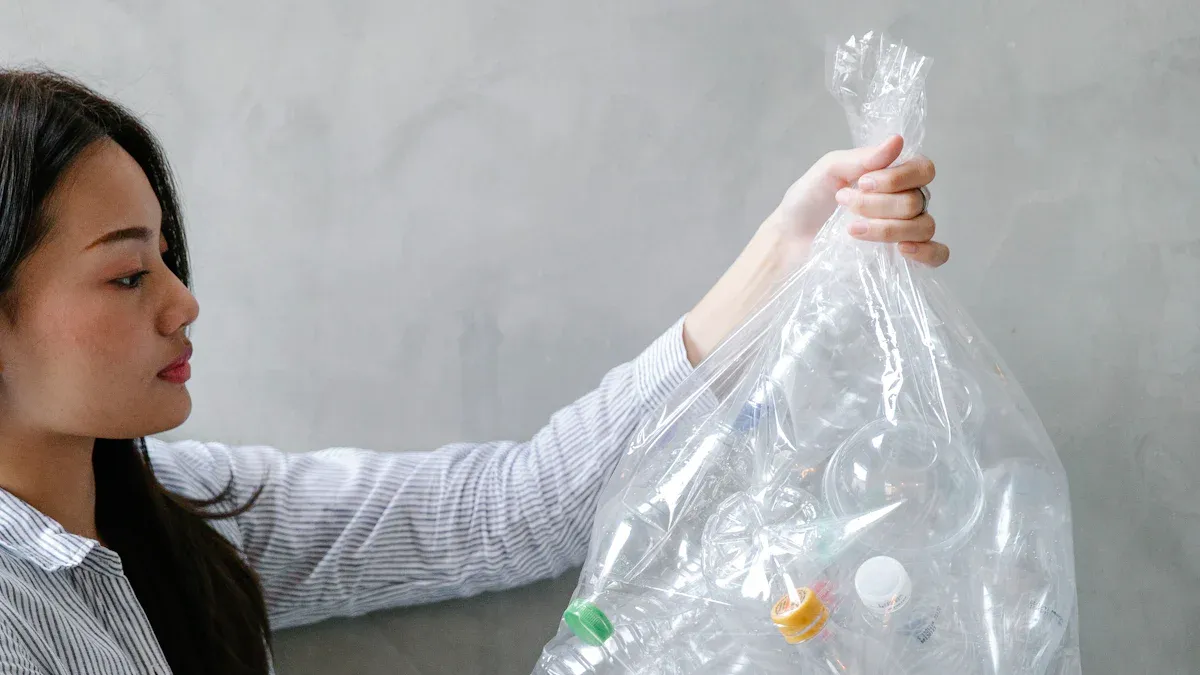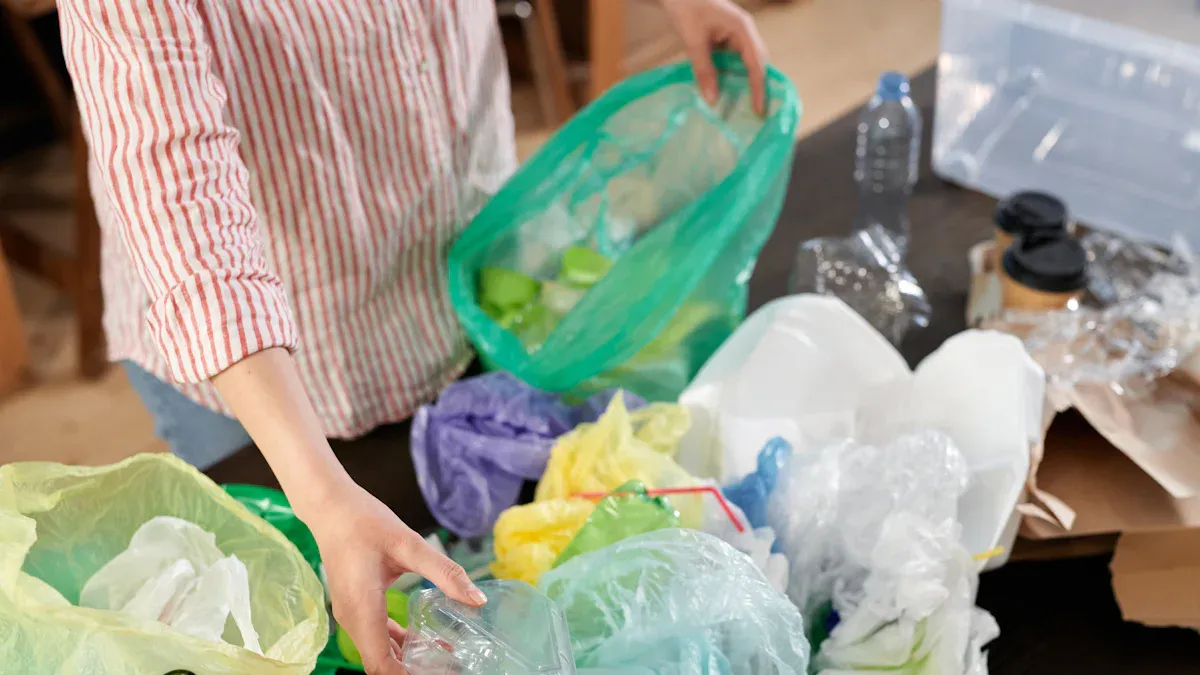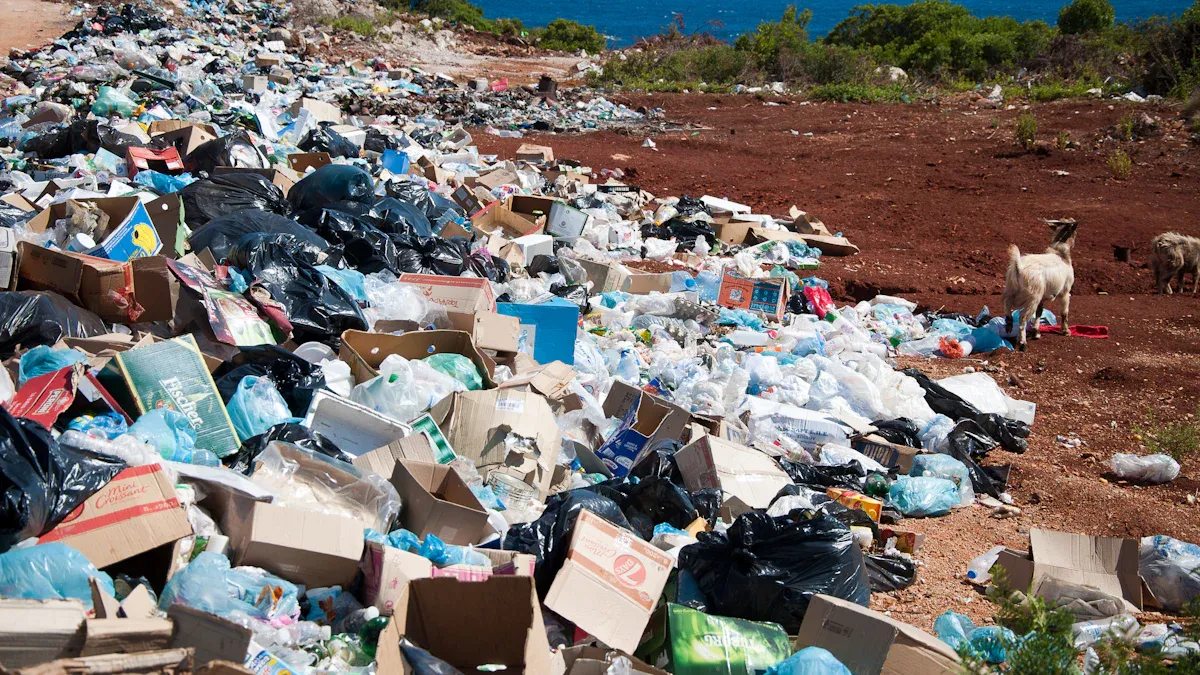- All
- Product Name
- Product Keyword
- Product Model
- Product Summary
- Product Description
- Multi Field Search
Views: 0 Author: Site Editor Publish Time: 2025-05-15 Origin: Site









Have you ever tossed a plastic bag into your recycling bin, thinking it’s the right thing to do? Unfortunately, that simple action can cause big problems. Plastic bags can clog up recycling machines, forcing facilities to shut down for repairs. Black plastic is another issue—it’s hard for scanners to detect, so it often ends up in landfills. To protect the environment, you need to follow proper recycling practices and find better ways to reduce or reuse these materials.
Plastic bags break recycling machines and cause expensive delays. Keep them out of your recycling bin to help things run smoothly.
Dirty recyclables might end up in landfills. Keep your recycling clean by not using plastic bags or other trash.
Black plastic is hard for machines to detect. This makes more trash go to landfills. Use clear or light-colored packaging instead.
Always make sure recyclables are empty, clean, and dry. Rinse them quickly to stop contamination and help recycling work better.
Help the planet by using reusable bags. Speak up for better recycling rules in your town.

When you toss plastic bags into your recycling bin, you might think you're helping the planet. But those bags can wreak havoc on recycling facilities. Plastic bags are thin and flexible, which makes them prone to tangling in sorting machinery. Imagine a conveyor belt jammed with twisted plastic—it’s a nightmare for workers and equipment. Recycling centers often have to shut down operations to untangle the mess, wasting time and money.
These delays don’t just slow down the process; they also increase costs for recycling programs. Repairs and downtime mean fewer resources are available to process actual recyclables. By keeping plastic bags out of your bin, you help recycling facilities run smoothly and efficiently.
Plastic bags don’t just damage machinery—they also contaminate other recyclables. When a load of recyclables gets mixed with non-recyclable items like plastic bags, the entire batch can be ruined. Recycling centers may have no choice but to send the contaminated load to a landfill.
Think about it: one plastic bag can undo the efforts of an entire neighborhood. Instead of being recycled, paper, glass, and metal items end up buried in landfills, where they take years to break down. Keeping plastic bags out of your bin ensures that recyclable materials stay clean and ready for processing.
You might wonder why curbside recycling programs don’t accept plastic bags. The answer lies in their design and impact. Plastic bags are lightweight and flimsy, making them difficult to sort. They can slip through machinery or get stuck, causing operational headaches.
Here’s why recycling programs refuse plastic bags:
They contaminate loads of recyclables, forcing facilities to discard everything.
They damage sorting equipment, leading to costly repairs and delays.
They aren’t recyclable through standard curbside systems due to their material composition.
Instead of placing plastic bags in your bin, take them to designated drop-off locations like grocery stores. These facilities have specialized equipment to handle plastic bags properly. Following these recycling practices helps reduce waste and keeps the system running efficiently.
Black plastic poses a unique challenge for recycling facilities. Most black plastic items are colored using carbon black pigments, which absorb infrared light. This makes them invisible to the Near Infra-Red (NIR) scanners used in sorting systems. Without proper detection, black plastic often gets misidentified as waste and ends up in landfills or incinerators.
Sorting machines struggle to identify even small amounts of carbon black. This complicates the recycling process and increases disposal rates. Optical sorting systems, which rely on light reflection, can’t detect the dark pigment. As a result, black plastic packaging is frequently deemed unrecyclable.
Tip: Avoid buying products packaged in black plastic whenever possible. Opt for items with clear or light-colored packaging, which are easier to recycle.
Black plastic is everywhere. You’ll find it in food containers, utensils, electronics, and even toys. Its sleek appearance makes it a popular choice for manufacturers, but it comes with hidden risks. Studies have found that black plastic items often contain toxic chemicals.
A 2018 study revealed that 40% of tested black plastic items contained toxic chemicals at levels up to 30 times higher than considered safe.
Another study in 2024 identified flame retardants in household products made from black plastic. These chemicals can disrupt hormones and increase cancer risks.
Next time you see black plastic, think twice. Its widespread use might seem harmless, but it’s a major environmental and health concern.
Black plastic contributes significantly to landfill waste. Recycling facilities can’t process it effectively, so it’s often discarded. The dark pigment prevents sorting machines from recognizing it, leading to increased disposal rates.
Every year, tons of black plastic end up in landfills. This waste doesn’t break down easily. It releases harmful chemicals into the soil and water, polluting ecosystems. By reducing your use of black plastic, you can help minimize its environmental impact.
Note: Choosing reusable alternatives, like glass or stainless steel, reduces landfill waste and protects the planet.
When it comes to recycling, following the "empty, clean, and dry" rule is a game-changer. You might not realize it, but even a small amount of leftover food or liquid can ruin an entire batch of recyclables. For example, a greasy pizza box or a half-full soda bottle can contaminate thousands of pounds of paper or plastic.
Keeping your recyclables clean and dry not only improves the quality of materials but also increases their market value. Clean items are easier to process and more likely to be turned into new products. So, before tossing that yogurt container into the bin, give it a quick rinse and let it dry. It’s a small step that makes a big difference.
Tip: Always check for residue before recycling. A little effort on your part can go a long way in supporting better recycling practices.
Not everything belongs in your recycling bin, even if it has a recycling symbol. Knowing what to include and exclude is crucial for avoiding contamination. Here’s a quick guide:
| Item | Include/Exclude | Reason |
|---|---|---|
| Cardboard boxes | Include | Easily recyclable |
| Plastic bottles | Include | High recycling value |
| Styrofoam | Exclude | Non-recyclable material |
| Plastic bags | Exclude | Clogs recycling machinery |
| Food waste | Exclude | Contaminates recyclables |
By sticking to this list, you help ensure that only the right materials make it to recycling facilities. This reduces contamination rates and improves the efficiency of the recycling process.
Every community has its own recycling rules, and following them is essential for effective waste management. For instance, some areas accept glass bottles, while others don’t. Local guidelines are designed to match the capabilities of nearby recycling facilities, so they vary widely.
Take San Francisco as an example. The city’s innovative recycling and composting programs have diverted millions of tons of waste from landfills. Their success comes from clear guidelines, strong leadership, and community participation. By learning and following your local rules, you can contribute to similar achievements in your area.
Note: Check your city’s website or recycling app for up-to-date information on what’s accepted in your bin.

Reducing your reliance on plastic bags is one of the simplest ways to protect the environment. Instead of grabbing disposable bags at the store, switch to reusable shopping bags. Many retailers even offer discounts when you bring your own bags—saving money while helping the planet.
Plastic bags don’t have to be single-use. You can repurpose them for everyday tasks like lining trash cans or storing items. Feeling creative? Try upcycling them into DIY projects. Some communities weave plastic bags into sleeping mats for homeless individuals, turning waste into something meaningful.
Tip: Keep a few reusable bags in your car or backpack. That way, you’ll always have them handy for shopping trips.
When it comes to plastic bags, proper disposal is key. Curbside recycling programs don’t accept them, but designated drop-off points—like grocery stores—do. These locations have specialized equipment to recycle plastic bags effectively.
Take a look at how proper disposal has made a difference:
| Case Study Location | Benefits Achieved |
|---|---|
| Lucas County, Ohio | Increased recycling rate with a reduction in costs and lower life-cycle environmental burdens. |
| Anderson County, South Carolina | Evaluated cost and environmental implications of a curbside recycling program, optimizing for least-cost options while enhancing environmental performance. |
By using drop-off points, you help reduce landfill waste and improve recycling practices. It’s a small effort that leads to big results.
You can make an even bigger impact by advocating for change. Push for sustainable packaging options and better recycling policies in your community. Many countries have adopted Extended Producer Responsibility (EPR) policies, which require manufacturers to take responsibility for their packaging waste. These policies have led to recycling rates exceeding 75% in some places.
Did you know? Implementing EPR policies in U.S. states could increase residential recycling rates by up to 48 percentage points. It would also create nearly universal recycling access and recapture millions in lost material economic value.
Start small by supporting businesses that use eco-friendly packaging. Share your concerns with local leaders and encourage them to adopt policies that prioritize sustainability. Your voice matters, and together, we can drive meaningful change.
Have you ever tossed something into the recycling bin, hoping it would magically get recycled? That’s called wishcycling, and it’s more common than you might think. People often assume that items like greasy pizza boxes, plastic bags, or Styrofoam can be recycled. Unfortunately, wishcycling does more harm than good.
When non-recyclable items end up in the bin, they contaminate the entire batch. Recycling facilities may have to send everything to a landfill instead of processing it. This wastes resources and defeats the purpose of recycling. To avoid wishcycling, stick to your local recycling guidelines. If you’re unsure about an item, it’s better to leave it out than risk contamination.
You’ve probably seen the recycling symbol on packaging and thought, “Great, I can recycle this!” But not so fast. Just because something has a recycling symbol doesn’t mean it’s recyclable in your area. Different materials have different recycling rates, and some are much lower than you’d expect.
Here’s a quick look at recycling rates for common items:
Natural HDPE bottles were slightly better at 29.3%.
Polypropylene containers lagged behind at just 8%.
By 2020, PET bottle recycling dropped to 27.1%, and HDPE bottles fell to 28.8%.
These numbers show that even widely used materials aren’t always recycled effectively. Local facilities may lack the infrastructure to process certain items, so it’s important to check what’s accepted in your area.
Recycling isn’t just about tossing items into the right bin—it’s about understanding the process and sharing that knowledge. Research shows that children and teens can influence their families’ recycling habits. Educational programs tailored to their developmental stages can make a big difference.
“Studies have developed models showing how children conceptualize recycling based on their cognitive development. Tailored education for different age groups leads to better understanding and practices.”
By educating yourself, you can make smarter choices and help others do the same. Start small by learning your local recycling rules, then share tips with friends and family. Together, you can create a ripple effect that benefits the planet.
Plastic bags and black plastic don’t belong in your curbside recycling bin. They create more harm than good by damaging equipment and contaminating recyclables. Eliminating these items from your bin can make a big difference:
Black plastic often ends up in landfills because sorting machines can’t detect it.
Many recycling facilities skip black plastic entirely, increasing waste.
Keeping plastic bags out improves recycling rates and reduces overall waste.
By reducing your use of these materials and disposing of them properly, you help protect the environment. Small changes in your habits can lead to a healthier planet for everyone.
Recycling facilities might remove the plastic bags manually, but they often end up in landfills. Worse, they can jam sorting machines, causing delays and extra costs.
Tip: Always double-check your recycling bin to keep non-recyclable items out.
Most curbside programs don’t accept black plastic because scanners can’t detect it. Some specialized facilities might handle it, but they’re rare.
Note: Avoid black plastic packaging when shopping to reduce waste.
Grease and food residue contaminate paper fibers, making them unsuitable for recycling. Only clean, grease-free cardboard can be processed.
Biodegradable bags break down faster than regular plastic, but they still require specific conditions to decompose. They can’t be recycled and might still harm wildlife if littered.
Check your city’s website or download a recycling app for accurate information. Many communities provide detailed lists of what’s accepted and where to recycle special items.
Did you know? Following local rules helps reduce contamination and improves recycling rates.